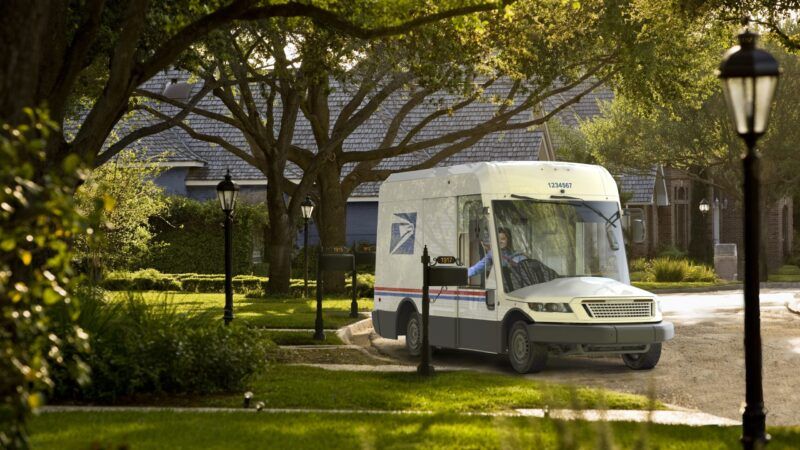10 Years and $3 Billion for a New Mail Truck?
Oshkosh Defense’s USPS van is thousands of dollars more expensive than the industry standard.

The new U.S. Postal Service (USPS) Next Generation Delivery Vehicles (NGDVs) have delighted drivers since hitting the road in Georgia last month, the Associated Press reports. But given the $5 billion investment required, taxpayers might be a tad less enthusiastic.
USPS prides itself on being "generally self-funded" through revenue from the sale of stamps, products, and services. As laudable and uncommon as this general self-funding is for federal agencies, USPS received $3 billion from the Inflation Reduction Act. USPS also has a pension system with a $50 billion unfunded liability for which the taxpayer may ultimately have to foot the bill, Reason's Eric Boehm explains.
Altogether, USPS expects its total investment in new vehicles to reach $9.6 billion. Considering a significant portion of this investment comes out of the U.S. Department of the Treasury (read: from taxpayers present and future), the public is entitled to scrutinize how this money was spent.
Of the 106,000 new delivery vehicles planned for purchase by 2028, 60,000 are NGDVs. Though exact prices are difficult to ascertain, the March 2022 order of 50,000 was valued at $2.98 billion. This brings the per-unit price of the NGDV to $59,600.
The duck-like NGDV is produced by Oshkosh Defense, the same company that manufactures the much scarier-looking Medium Caliber Weapon System, an armored combat vehicle armed with a 30 mm turret. Oshkosh's NGDV will be phased into USPS's fleet over the next four years to replace the iconic truck that has comprised its fleet since 1987: the Grumman Long Life Vehicle (GLLV), produced by the military contractor in partnership with General Motors, Poveco, and American Motor Corporation.
Did you know the new NGDV comes with built-in safety and ergonomic features designed to enhance both driver and pedestrian safety, while also making delivery routes more efficient?
If you want to do work that makes a difference in people's lives, visit https://t.co/TKYGgifAOE pic.twitter.com/mGcRQiMVLL
— Oshkosh Defense (@OshkoshDefense) August 14, 2024
The Oshkosh NGDVs boast features lacking in the GLLV, such as airbags, anti-lock brakes, collision sensors, and blind-spot monitoring—features that have been standard for years in modern vehicles. Oshkosh says it won the $3 billion "competitively-awarded" contract for 50,000 NGDVs in 2021. But comparing the per-unit price to industry-standard alternatives, Oshkosh must have a 21st-century helicopter parent definition of competition.
In March 2022, Postmaster General Louis DeJoy initially planned for 10 percent of the NGDVs to be electric, as the USPS illustrates in a helpful graphic. Following lawsuits brought about by the attorneys general of 16 states, as well as the Center for Biological Diversity, Earthjustice, CleanAirNow Kansas City, and Sierra Club California, DeJoy increased the portion of electric vehicles to over 50 percent by July 2022. By December 2022 that figure had increased to 75 percent.
Electric vehicles are about 17 percent more expensive than comparable internal combustion engine alternatives, according to automotive research company Kelley Blue Book. Accordingly, if the Oshkosh Defense contract were updated to reflect the increased proportion of more expensive electric variants of its NGDVs, the total value would be closer to $3.31 billion, making the average price per NGDV $66,200.
The manufacturer's suggested retail price (MSRP) of the 2025 Mercedes-Benz e-Sprinter, the likes of which are used in FedEx's private fleet, is $61,180—$5,000 less than the price of the Oshkosh NGDV. The non-electric Mercedes-Benz Sprinter had an MSRP of $42,430 in 2021, per Kelley Blue Book, when the USPS-Oshkosh deal was made. That's $17,000 less than the NGDV per-unit price of $59,600.
No matter how you slice it, the USPS-NGDV program has been an expensive boondoggle. It has dragged on for nearly a decade since its inception in July 2014, while the market capitalizations of private competitors like UPS, FedEx, and DHL have grown. As it turns out, you don't need to outsource vehicle manufacturing to the military-industrial complex to deliver mail.


Show Comments (62)